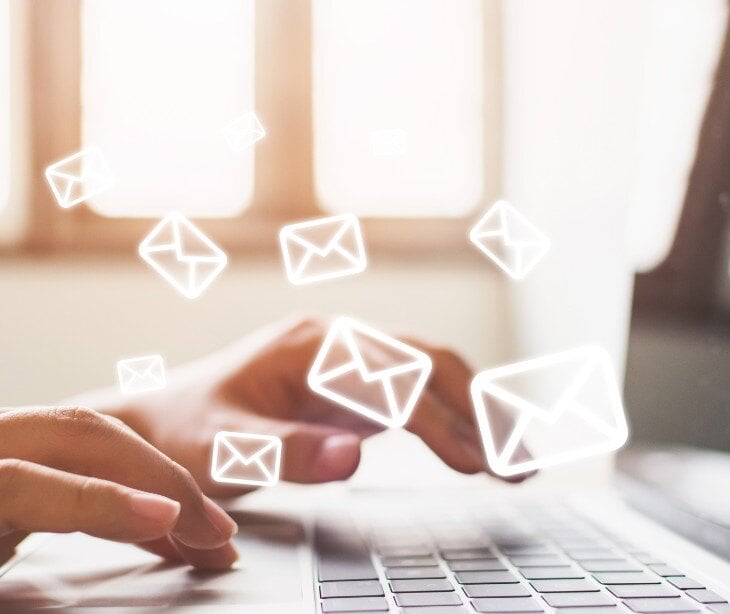
Healthcare billing requires that healthcare organizations share sensitive patient information, comprising codes for bill processing, charges and expenses incurred by patients, and information regarding insurance coverage. Cybercriminals target this information, as seen with the Change Healthcare cyberattack, which shut down more than 100 healthcare-related operations, including those related to pharmacy, medical records, clinical, dental, patient engagement, and payment services.
Privacy concerns can be negatively impacted, and patients may lose trust in healthcare organizations if any data is leaked or intercepted during the billing process. To avoid compromising privacy and causing patient distrust, healthcare organizations must adhere to the guidelines outlined in HIPAA regulations by creating designated email communication channels for billing purposes.
The billing process
- Patient registration: The first step is collecting personal and insurance information. This includes data such as the patient's name, address, date of birth, and insurance details to create a complete patient profile.
- Insurance verification: Confirming the patient’s coverage involves checking with the insurance provider to ensure that the patient's policy is active and understanding the extent of their benefits and any co-pays or deductibles.
- Charge entry: Translating services into billable charges using specific codes. Healthcare providers use coding systems like CPT (Current Procedural Terminology) and ICD (International Classification of Diseases) to document services provided and diagnoses.
- Claims submission: Sending claims to insurance companies for reimbursement. This step involves compiling all relevant information and submitting it to the insurance company for payment processing.
- Payment posting: Recording payments received from insurance companies. This ensures that the provider's financial records are up-to-date and accurate.
- Patient billing: Issuing invoices to patients for any outstanding amounts. After insurance has paid its portion, patients are billed for any remaining balance, such as co-pays or deductibles.
- Collections: Following up on unpaid claims or bills. This involves contacting patients and insurance companies to resolve outstanding balances and ensure timely payment.
Why HIPAA is a requirement in healthcare billing
Protecting PHI
To safeguard patient privacy and remain compliant with legal requirements, healthcare providers must protect all information concerning health status, healthcare provision, or payment for healthcare that can be linked to a specific individual. Maintaining the confidentiality, integrity, and accessibility of this protected health information (PHI) in billing processes within the healthcare industry should always be prioritized.
Legal implications of non-compliance
Non-compliance with HIPAA can result in severe penalties, including substantial fines (ranging from $137 to $68,938 per violation) and legal action including jail time and civil lawsuits. Organizations must adhere to HIPAA regulations to avoid these consequences and maintain their reputation.
Go deeper: What are the consequences of not complying with HIPAA?
In the news: Going deeper: The Change Healthcare attack
Building patient trust and confidence
Patients trust healthcare providers to protect their sensitive information. Demonstrating a commitment to HIPAA compliance helps build and maintain this trust, which is vital for the provider-patient relationship.
A study from the International Journal for Quality in Health Care (IJQHC) demonstrated that patients are more likely to trust and remain loyal to healthcare providers that demonstrate robust data protection practices.
Financial repercussions of data breaches
Data breaches can lead to significant financial losses due to fines, legal fees, and the cost of breach mitigation efforts. It's estimated that a healthcare data breach can incur costs reaching $10.93 million per year. Protecting PHI through HIPAA compliant practices helps prevent these costly incidents.
What to consider when choosing a HIPAA compliant email service provider
- Business associate agreement (BAA): A BAA is a contract that specifies the responsibilities of the email service provider in safeguarding PHI. Ensure that your provider is willing to sign a BAA, as this is a non-negotiable requirement for HIPAA compliance.
- Encryption requirements: Encryption is essential for protecting PHI during transmission. It ensures that emails cannot be read by unauthorized parties while being sent from the sender to the recipient.
- Access and audit controls: Implementing strict access controls ensures that only authorized personnel can access PHI. Audit controls involve maintaining detailed logs of email activities, which helps in monitoring and ensuring compliance.
Related: Using HIPAA compliant email for billing purposes in healthcare
PHI in billing email
Personal Health Information (PHI) in billing emails contains data that could identify an individual and is related to their health status, healthcare services, or payment details. This may include names, addresses, social security numbers, medical record numbers, financial information, and other personal identifiers linked to the patient's health history and treatment. To comply with HIPAA regulations, PHI must be protected when included in billing communications. This means using encrypted email services, disclosing only necessary PHI, and ensuring that only authorized personnel have access to the information. Proper handling of PHI in billing emails not only prevents unauthorized access and potential breaches but also helps maintain patient trust and the healthcare provider's reputation for confidentiality and security.
Tips for safeguarding PHI in billing emails
- Use encrypted email services: Ensure your email service provider offers encryption to protect PHI during transmission and at rest. This is a critical step in safeguarding sensitive patient information from unauthorized access.
- Limit PHI in emails: Only include the minimum necessary information needed to fulfill the purpose of the email. This reduces the risk of exposure and ensures compliance with the "minimum necessary" standard of HIPAA.
- Obtain patient consent: Before sending PHI via email, obtain explicit consent from the patient. Inform them of the risks and have them sign a consent form.
- Use secure links for documents: Instead of attaching sensitive documents directly to emails, provide secure links to files stored in a HIPAA compliant cloud storage service.
- Implement access controls: Ensure that only authorized personnel have access to PHI. Use strong passwords, two-factor authentication (2FA), and role-based access controls.
- Regular staff training: Conduct regular training sessions to educate staff on HIPAA requirements, recognizing phishing attempts, and best practices for handling PHI. Continuous education helps maintain a high standard of security awareness.
- Include confidentiality notices: Add a confidentiality notice to your email footers, reminding recipients that the email contains sensitive information and instructing unintended recipients on how to handle it.
- Monitor and audit email activity: Regularly monitor and audit email activities to detect any unauthorized access or breaches. Maintain logs of who accessed the information and when. This helps identify and mitigate potential security issues.
- Use strong passwords: Ensure that all accounts used to send emails containing PHI have strong, unique passwords.
- Regularly update security measures: Keep your email software and security measures up to date to protect against new threats and vulnerabilities.
See also: HIPAA Compliant Email: The Definitive Guide
FAQs
Why is patient consent important in billing emails?
Patient consent in billing emails ensures that patients are aware of and agree to using their sensitive information for communication purposes. By obtaining explicit consent from patients before sending billing emails, healthcare providers uphold the principle of patient autonomy and respect their right to control how their information is used. Patient consent serves as a form of protection, ensuring that patients are informed about the risks associated with email communication, such as the potential for unauthorized access to their personal and medical information.
What are the potential risks of sending billing information via email?
Sending billing information via email poses several risks, including the potential for unauthorized access to sensitive patient data, interception by third parties, and breaches of patient privacy. Additionally, email communications may not always be secure, making them susceptible to hacking or phishing attempts.
How can patients be educated about the risks and benefits of email communication in healthcare billing?
Patients can be educated about the risks and benefits of email communication in healthcare billing through informative brochures, consent forms, and discussions during healthcare visits. Providers should clearly explain the potential risks of unauthorized access to PHI and the measures in place to protect patient privacy when communicating via email.
Subscribe to Paubox Weekly
Every Friday we'll bring you the most important news from Paubox. Our aim is to make you smarter, faster.




